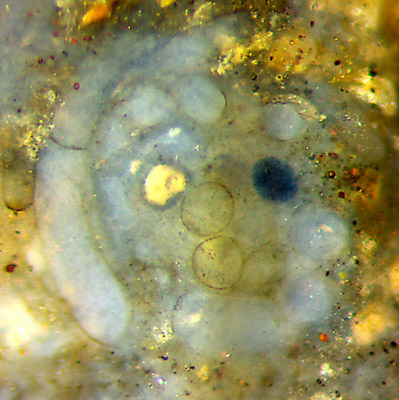Charophyte lacking gyrogonites --- Palaeonitella
centenary
A fossil alga from the Lower Devonian Rhynie chert
was named Palaeonitella cranii in
1921 [1] for its resemblance to the extant charophyte alga Nitella.
It had been thought to grow gyrogonites
for propagation like any stonewort-like charophyte alga but "no
specimens of the
characteristic reproductive organs of the Characeae has as yet been
found in the Rhynie deposit" [1].
Decades later,
a few objects with spiralling aspect allegedly representing the elusive
gyrogonites were found, hovever scattered and poorly
preserved [2]. They were
used for an emended diagnosis of Palaeonitella,
including a fanciful reconstruction [2]. 
The elusive gyrogonites at Rhynie and the own
finds of algae
there provide quite another view, surprising as it seems: Most or even
all stonewort-like charophyte algae in
the Rhynie chert would never have grown gyrogonites but organs
preceding them in evolution: oogonia without screw-like
coating, nicely arranged at the top
of the alga like
stamina on a flower (Fig.1, more related pictures at [3]). Charophytes
with simple oogonia are highly peculiar because they must be relics
from bygone times when gyrogonites had not yet evolved.
The
question arises why the smooth oogonia have escaped the
palaeobotanists' notice for a hundred years, although they are clearly
seen on some own samples. (A related short paper sent to
Paläontologische
Zeitschrift in 2019 had been rejected.) As a possible answer, they
are seldom as conspicuous as in Fig.1. Most often they are less clearly
seen and likely to be mistaken for chlamydospores of unidentified
fungi, as in Fig.2.
Incidentally
the only objects which can doubtless be identified as oogonia in Fig.2
are those with obscure black and white fills. The transparent
spheres in the foreground visualize the difficulty of telling smooth
oogonia apart from fungus globules.

Fig.1
(above): Cross-section of a charophyte alga top end in Rhynie chert
with an inner circle of ellipsoid- or bean-shaped smooth oogonia,
mostly with dark fill, on
slender stalks (not seen here), surrounded by cross-sections of the
upright branches of the uppermost whorl.
Image 1mm.
Fig.2: Lateral view of a slightly deranged charophyte
alga top end in Rhynie chert
with a few oogonia and branches
of the uppermost whorl,
with different orientation to the cut plane. Image 1mm.
The vain search for gyrogonites has not been useless because it has led
to the assumption that Palaeonitella
cranii
[1] might represent the
same species as the lately discovered charophyte alga with
smooth oogonia, which would explain the lack of gyrogonites. This
would imply that Palaeonitella
cranii is
not just another one among the many known charophyte algae but is an
ancient species which had not taken the evolutionary step from simple
oogonia to gyrogonites. Hence, its place on the phylogenic tree must be
on a branch coming up from deep Silurian, well separated
from the
lot of the others. Apparently this particular branch ended soon since
charophytes with simple oogonia without patterned coating have not been
found in geological formations younger than Devonian.
In addition to this unexpected result, a less important thought may be
mentioned: The genus name Palaeonitella,
according to present
knowledge denoting an ancient species lacking gyrogonites, should not
be applied to fossils of advanced charophytes resembling Nitella, as done in
2021 [4].
Samples: Fig.1: Rh10/42.2
(2013), Fig.2: Rh9/86.2 (2003)
H.-J.
Weiss
Dec.
2021
[1]
R. Kidston, W.H. Lang: On Old Red Sandstone plants showing
structure ... Part V...
Trans. Roy. Soc.
Edinburgh 52
(1921), 855-902.
[2]
R.Kelman, M. Feist, N.H. Trewin, H. Hass: Charophyte algae
from the Rhynie chert.
Trans. Roy. Soc.
Edinburgh 94
Part 4 (2004 for 2003), 445-455.
[3]
H.-J. Weiss: Google: Chertnews: Rhynie Chert News
73, 89, 90, 138, 139.
[4]
C. Martin-Closas et.
al.: Palaeonitella
trifurcata, a
cortoid-building charophyte ...
Rev. Pal.
Pal. 295 (Dez.2021), 104523
 |
 |
183 |





